In October 1883, nine august gentlemen met to discuss the establishment of a Victorian branch of the Geographical Society of Australasia (GSA). New South Wales had established the Society in June 1883. The Victorians met to decide if they would establish a separate branch or incorporate their group within the Royal Society of Victoria.
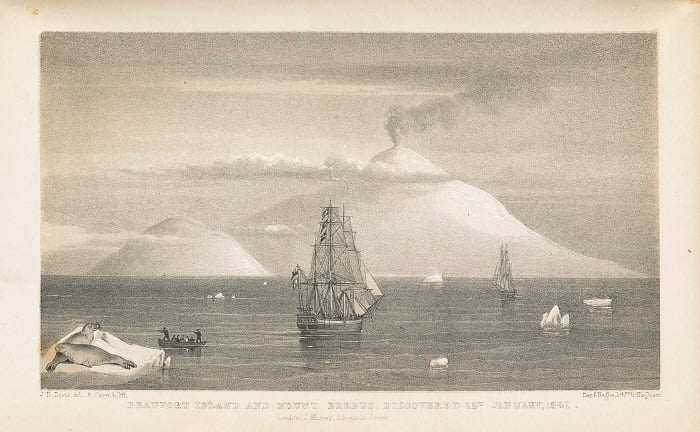
James Ross expedition discovers Mt Erebus (p.216)
With the vote locked at four all, chairperson Thomas Bride (at the time our Chief Librarian), cast the deciding vote that established the Victorian branch of the GSA (shortly to become the Royal Geographical Society of Australasia).
Melbourne was a booming and confident city. Not for the men (and they were all men) of the Geographical Society to limit their ambitions to the vast Australian continent, they also had an eye southward, towards the even vaster Antarctic continent.
Antarctica was the final geographical mystery. At that time there had been no confirmed landing on the continent.[1]
In the 1820s intrepid sealing fleets had all but destroyed the seal populations on the islands at the edge of Antarctica. The major powers, still impatiently carving the world into colonies, were curious.
Extraordinary explorations were launched – by the British under James Cook (1772 -1775) and James Clark Ross (1839–1843), Russia under Faddei Bellingshausen (1819–1821), United States under Charles Wilkes (1838–1842) and the French under Dumont D’Urville, (1837–1840). But by the 1880s the great powers had lost interest.
The truth was that though the Antarctic was greatly unknown, what little that was known suggested there would be no economic or strategic benefits, and considerable danger to crews, ships and the public purse in such an inhospitable, impenetrable and remote area of the world. James Cook’s initial view – ‘land doomed by nature to everlasting frigidness and never once to feel the warmth of the suns’ rays, whose horrible and savage aspect I have no words to describe;’[2] – seemed utterly accurate
Undaunted, men from the Victorian Royal Society and Geographical Society formed an Antarctic Exploration Committee. The committee included such notables as Ferdinand Von Mueller, Robert Ellery, William Kernot and Dr Bride.
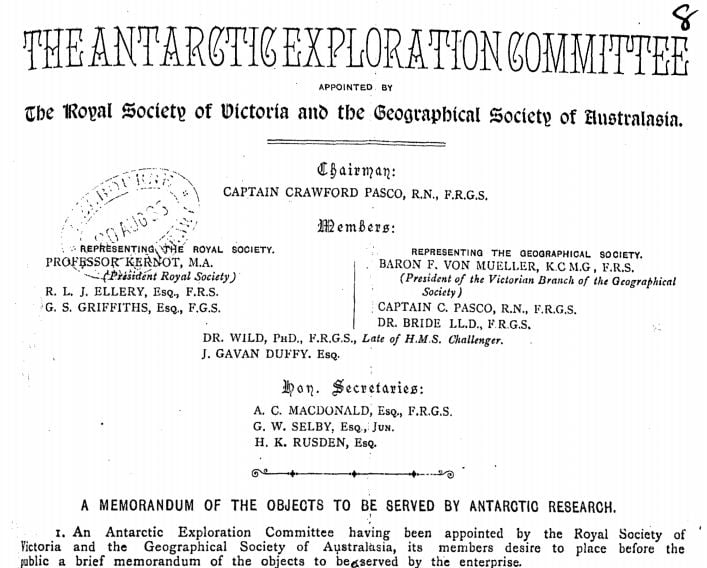
This committee convinced the Victorian Premier Duncan Gillies to promote their aims through Victoria’s Agent General in London, Graham Berry.
Berry was very active and there were no shortage of interested northern whalers, who, with falling yields, were very keen on the chance of a subsidised reconnaissance of Antarctic whaling grounds. The AEC was in close contact with Arctic veterans Erasmus Ommanney and Clements Markham, who themselves were attempting to raise interest in a British expedition.
Finally the AEC formed a partnership with famed Arctic explorer Adolf Nordenskiöld[3]. Unfortunately, despite their best efforts, the funding they sought to raise didn’t ever eventuate and the AEC did not succeed in launching an expedition.
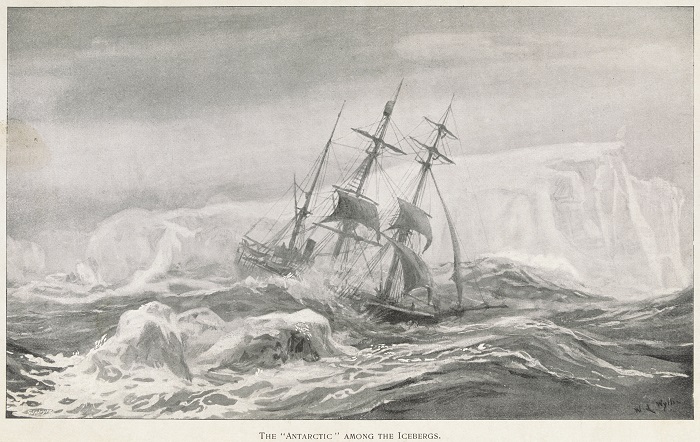
The cruise of the Antarctic to the South Polar regions by H.J. Bull. (Frontispiece)
They did, though, help inspire the first publicly recorded landing on the Antarctic continent by Henrik Bull and crew of his whaling expedition. Bull was a Norwegian who had come to Melbourne to try and make his fortune after squandering his business and his wife’s inheritance. Inspired and encouraged by the work of the AEC Bull managed a whaling and exploratory voyage to the Antarctic.
As a commercial enterprise it was a dismal failure. The whales of the southern ocean were rarely threatened and the seal skins his expedition collected were sold at a loss. Bull and several of his crewmates, though, did set foot on Cape Adare, Antarctica in January 1895. Bull rather ruefully noted:
The sensation of being the first men who had set foot on the real Antarctic mainland was both strange and pleasurable, although Mr. Foyn would no doubt have preferred to exchange this pleasing sensation on our part for a Right whale even of small dimensions[4]
Despite the commercial failure of the voyage, the landing created a sensation. The AEC hosted several receptions when the expedition returned to Melbourne. William Kernot lauded them as the “Columbus’ of the South” noting that there were:
‘…very few people in the history of the world who could say they were the first to place a foot on a new continent…. 1895 repeated 1492, the last of the great continents’[5]
Ambitious crewman, Carsten Egeberg Borchgrevink, (another Norwegian living in Australia) raced to the Sixth International Geographical Congress in London to deliver a paper on the landing and his scientific observations. His appearance was greeted with great enthusiasm.
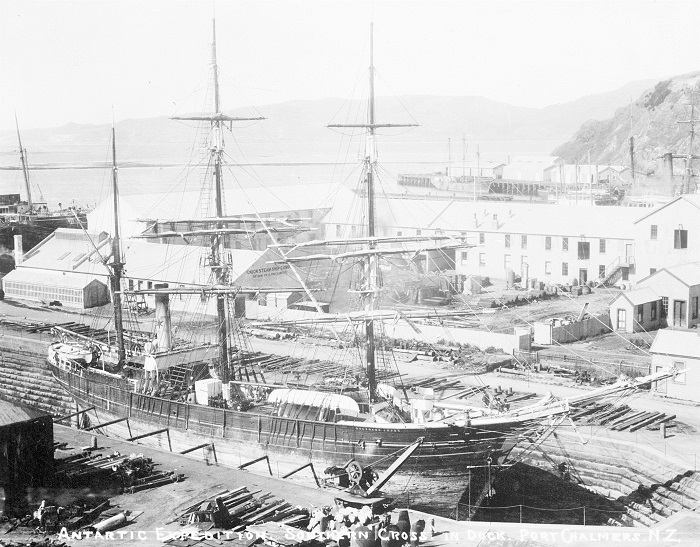
With fierce determination Borchgrevink managed to raise funds to lead the first overwintering on the Antarctic continent (1898-1900). There followed the famous explorations of the early 20th Century as the great powers again became interested in Antarctica.
It may be drawing a very long bow, but let’s give our Dr Thomas Bride some credit for setting this exploration in motion through the casting vote that created the Victorian branch of the Geographical Society. This led to the formation of the joint Antarctic Exploration Committee, encouraging Henrik Bull’s expedition, and keeping the hope of Antarctic exploration alive when the rest of the world had lost interest.
Notes
[1] On 7 February 1821 it is likely that John Davis, captain of the American sealing ship Huron, landed on the Antarctic Peninsula while searching for new sealing ground.. This landing, though, was unknown until his logbook was rediscovered in 1952.
[2] The three voyages of Captain Cook round the world. by James Cook Vol 4 p.222
[3] Adolf Nordenskiöld, a Finnish political exile living in Sweden, was a notable Arctic explorer who led the first expedition to complete the North East Passage in the Siberian Arctic 1878-9. Had the joint scientific expedition between Nordenskiöld and the Antarctic Exploration Committee gone ahead, it would have been very significant.
[4] The cruise of the Antarctic to the South Polar regions by H.J. Bull. p.181. Wealthy Norwegian whaler Svend Foyn funded the expedition.
[5] Royal Geographical Society of Australasia (Victoria). Meeting 2 April 1895 Minutes. (Held at Royal Historical Society of Victoria MS 000688.)

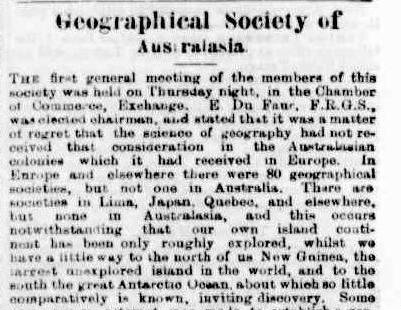

Wow, what an awesome story Andrew, loved the pictures and the recalling of the history of the Geographical Society of Australasia and Thomas Bride, along with the Antarctic exploration. Great post!
Cheers Ken
Yes Antarctic history is endlessly fascinating
Andrew
Yes, I think Thomas Bride absolutely can take some credit for establishing Antarctic exploration. It puts paid to the notion that librarians are feckless individuals who love poetry and cats, for they want to strike out for the South Pole!
The Royal Geographical Society of Australasia (Victoria Division), formed in 1883, amalgamated with the then Victorian Historical Society in 1924, which is why their collection of books and papers can be found at the Royal Historical Society of Victoria today. The RGSA (Vic Division) book collection included many interesting volumes about exploration, including a book called “Explorations in Australia” by John Forrest, published in 1875. It appears that this copy at one time had been owned by “Harry H Morant”, as his autograph appears inside the cover.
Wonderful historical recap Andrew. Loved hearing the story of the Antarctic Exploration Committee. Glad you had the historical pictures and notes to go with it as well. Awesome documentation and story, thanks for sharing this!
Wow, I had never heard this story of the exploration of the Antarctic or how the Victorian branch of the Geographical Society of Australasia played a part in it. Wonderful history and appreciate you sharing these facts and pictures.